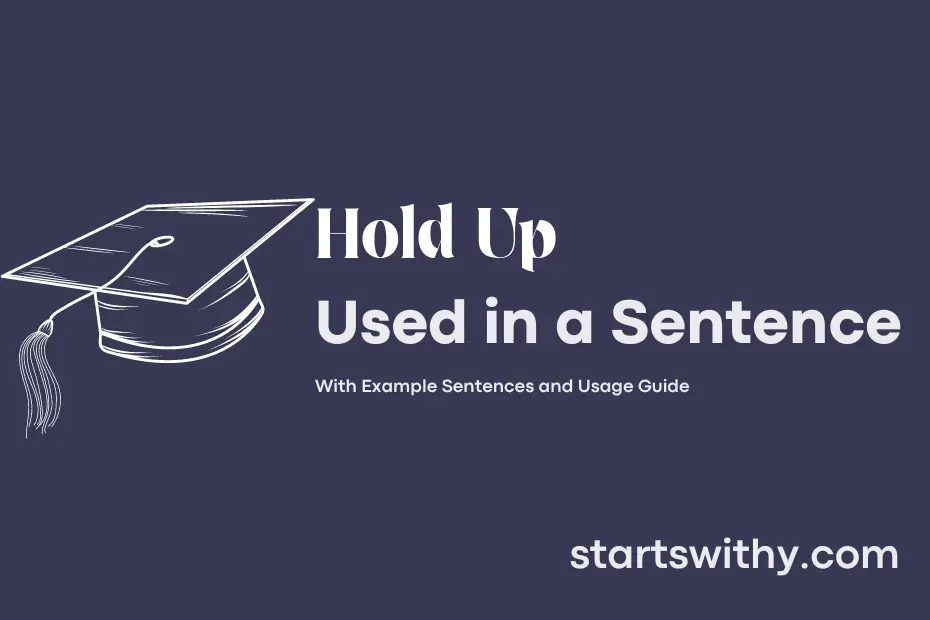Have you ever encountered a situation where you needed to pause or delay something for further clarification or consideration? This is what we refer to as a “hold up” in conversation. Essentially, a “hold up” is a phrase used to indicate the need for a momentary stop or delay in a conversation or activity.
Using “hold up” in a sentence can help convey the idea of pausing or seeking clarification in a direct and informal manner. It is a useful expression in various contexts, whether in casual conversations among friends or during formal discussions in professional settings. Let’s explore further how “hold up” can be effectively incorporated into everyday communication.
7 Examples Of Hold Up Used In a Sentence For Kids
- Hold up your pencil and paper.
- Can you hold up all five fingers?
- Let’s hold up our hands to answer the question.
- Hold up your bag so I can see it.
- We must hold up the flag during the national anthem.
- Please hold up your book so I know you are ready.
- Hold up your favorite toy and show your friends.
14 Sentences with Hold Up Examples
- Hold up, did you finish the assignment for Professor Rao’s class?
- Hold up, I need to get my notes before we head to the library.
- Hold up, I forgot my ID card – can you get into the cafeteria without it?
- Hold up, let me check if the cafeteria is still open before we walk all the way there.
- Hold up, I need to grab my headphones before we start studying.
- Hold up, I think I left my textbook in the classroom, I’ll be right back.
- Hold up, I need to print out my essay before our next class.
- Hold up, I need to add money to my college ID for photocopies.
- Hold up, I can’t remember the deadline for that group project – can you look it up?
- Hold up, I need to find a quiet spot to take this phone call.
- Hold up, before we go to the event, let’s make a plan for how we’ll get back to the hostel.
- Hold up, do you think we should take the bus or a rickshaw to the market?
- Hold up, can we stop for a quick snack at the canteen before our study session?
- Hold up, let me finish this paragraph before we discuss the next topic.
How To Use Hold Up in Sentences?
Hold Up is used to interrupt someone or something in a conversation or an action. When using Hold Up in a sentence, it is essential to understand its purpose and appropriate usage.
To use Hold Up in a sentence, simply insert it in a situation where you need to pause or stop someone or something from proceeding further. For example: “Hold up, let me finish what I was saying before you continue.” This indicates to the listener that you need a moment to express your thoughts or complete your task.
When using Hold Up, it is important to be respectful and polite in your tone and manner. It should not be used to rudely interrupt or dismiss others, but rather to interject in a considerate and constructive way.
Remember that Hold Up can also be written as “hold on” or “wait a moment,” depending on the context and formality of the conversation. It is a versatile phrase that can be used in various situations to politely request a pause or delay.
Overall, using Hold Up in a sentence effectively requires awareness of its intended meaning and how it can impact communication. By incorporating it thoughtfully into your conversations, you can effectively convey your need for a pause or interruption without being abrupt or disrespectful.
Conclusion
In conclusion, sentences with “hold up” are often used to indicate a delay, obstruction, or interruption in a process or action. They can refer to situations where something or someone is causing a pause or hindrance, such as in “I’m stuck in traffic, so I’ll be a bit late, hold up for a few minutes.” These phrases are crucial for effective communication as they convey a need to stop or wait for a certain period.
Additionally, sentences with “hold up” can also imply support, protection, or durability, like in “This rope can hold up to 500 pounds.” This highlights the strength or resilience of an object or individual. Understanding and using sentences containing “hold up” in context can help convey clear messages about delays, obstacles, strength, or endurance in various situations.



